61 F. maximum temperature in St. Cloud yesterday.
71 F. average high on May 24.
80 F. high in the cities on May 24, 2016.
May 25, 2008: An EF-3 tornado strikes Hugo, MN. 1 fatality and 9 injuries are reported.
Holiday Weekend? Keep Weather Expectations Low
The
National Weather Service has upgraded the intensity of the tornado that
ripped across northern Wisconsin on May 16, destroying a mobile home
park near Chetek. It was an EF-3, with winds up to 145 mph. On the
ground for 83 miles it was one of the longest-track tornadoes on record
in Wisconsin's historical record, which goes back to 1950.
The
vast majority of tornadoes close to home are small and brief, but every
now and then we see a Texas-size twister. On May 25, 2008 an EF-3
tornado hit Hugo, Minnesota, with one fatality and 8 injuries.
One
silver lining to our recent cool snap: fewer severe thunderstorms than
usual, to date. That may change in early June. Long-range models still
hint at 80s and steamy dew points within about 2 weeks.
The
Memorial Weekend forecast won't win any awards, but we've seen worse. A
few instability pop-up showers are likely, especially late afternoon
hours every day. Monday looks like the coolest, wettest day. Much of
Saturday and Sunday will be partly sunny with 70s. A little cool for the
lake, but a solid B on our heavily-biased, erroneously lop-sided
weather-grading scale.
Check out a
video of yesterday's weather column, courtesy of
TruScribe.
Text to video has amazing potential, and digital storytelling options
continue to advance at a remarkable pace. My thanks to friend and
TruScribe CEO Odeh A. Muhawesh for passing this along. Very cool.
May 16 Wisconsin Tornado Upgraded to EF-3, On Ground for 83 Miles. This was a Kansas-size tornado in the North Woods of Wisconsin; details via
NOAA: "
A
powerful thunderstorm tracked across northwest Wisconsin during the
early evening of 5/16/2017. The storm produced a strong, 83 mile long
track tornado which affected 4 counties. The tornado first developed
over southeastern Polk County, east of Clear Lake, then tracked mostly
eastward across southern Barron and southern Rusk counties, to the
southwest part of Price County. One hard hit area occurred just north
of Chetek, WI where high-end EF2 damage was found. The greatest damage
that was observed occurred north of the Village of Conrath, Rusk County.
A family home was completely collapsed down to the foundation and was
rated EF-3 (145 mph). The remainder of the tornadoes path ranged from
EF0 to EF1 with mainly tree damage, and mostly minor structural damage.
This is one of the longest track tornadoes ever to have occurred in
Wisconsin since official National Weather Service records which began in
1950."
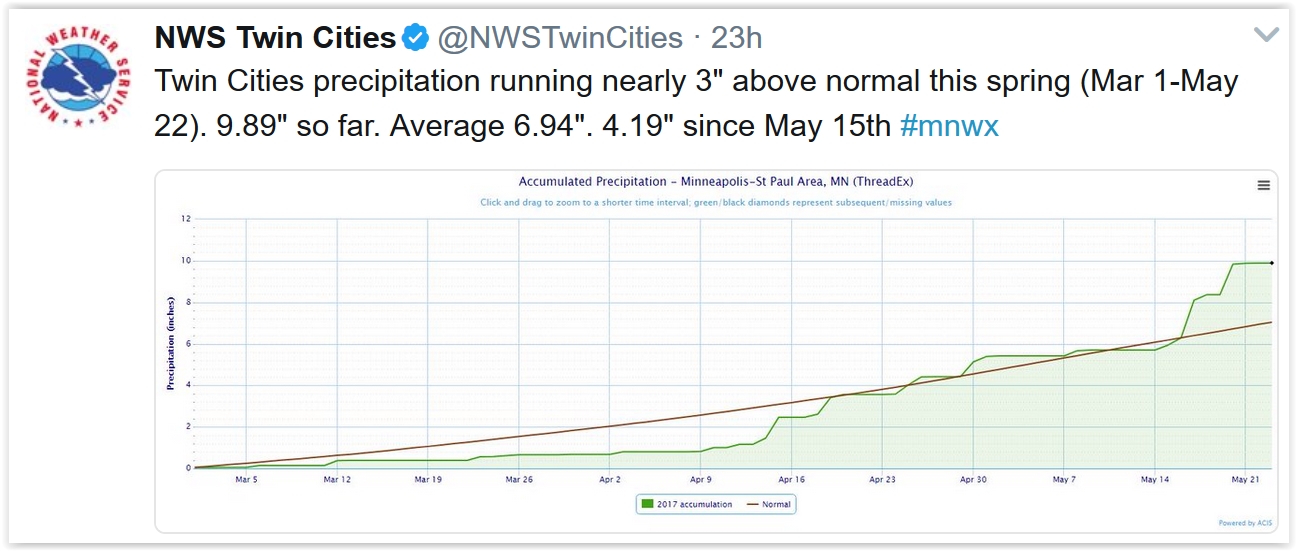
Lukewarm Weekend - Cooler on Memorial Day.
Not exactly stinking-hot, but low 70s will feel OK Friday into Sunday
before a northwest wind kicks in, cooling us down again by Monday -
probably the worst outdoor day of the holiday weekend. ECMWF forecast
for the Twin Cities: WeatherBell.
Foul Weather Lingers Eastern Half of USA.
A slow-moving storm grinds up the Mid Atlantic coast into New England
with pockets of heavy rain likely. Another system pushes heavy showers
and T-storms across the Ohio Valley by Sunday. Meanwhile the western
USA, southwest and Gulf Coast enjoys relatively dry, quiet weather.
84-hour Future Radar: NOAA's 12 km NAM and Tropicaltidbits.com.
In Search of Summer.
Hard to believe that meteorological summer kicks off in 1 week, with a
cool, wet bias for much of the eastern USA. A storm pushing up the East
Coast may create coastal flooding from Norfolk to Annapolis and metro
New York City. Meanwhile, a windy fetch across Lake Michigan carves out
some 5-8 foot waves, creating a risk of beach flooding and erosion in
the Chicago area. Map: Aeris AMP.
Make. It. Stop.
Many Americans living east of the Mississippi will be shaking their
fists at the sky in the coming days; the pattern stuck in something
resembling mid-April, not late May. Somme 2-4" rains are possible from
the Hill Country of Texas to the Ohio Valley and New England. Meanwhile
the west coast enjoys an extended streak of (well-earned) sunshine and
warmth.
 Huge Landslide Buries More of Scenic California Highway
Huge Landslide Buries More of Scenic California Highway.
Huffington Post as the details: "
A
massive landslide covered a section of California’s famous Highway 1
last weekend that’s been beset by falling rocks and debris this year.
Video footage released by the Monterey County Sheriff’s Department on
Monday shows a 35-40 layer of dirt and rock atop a 1/3-mile stretch of
the roadway in Big Sur. “Mother nature hard at work,” said a tweet from Caltrans,
the state’s transportation department. Images recorded from the
sheriff’s department’s plane shows that the debris reshaped the shore
beneath the highway..."
73% of Sunscreens Don't Actually Work. A story at
Newsweek made me do a double-take: "...
This week, the Environmental Working Group released its 11th annual sunscreen guide
to make selecting protection far less stressful. The EWG, a Washington,
D.C.-based research organization that monitors the safety of consumer
products and lobbies for stricter regulations, reviewed formulations of
more than 880 beach and sport sunscreens, 480 moisturizers and 120 lip
products with sun protection factor, or SPF. And they made a surprising
and disappointing discovery. Based on a review of disclosed ingredients
on product labels, they found that 73 percent of sunscreens don’t
actually work..."
Climatological Risk of Wildfires.
Some may be surprised to hear that NOAA SPC does more than track severe
weather and issue storm watches. They also outline areas of the USA
susceptible to wildfires.
Here's a link to historical wildfire data, by date.
Forecasters Agree: This Summer to be "Substantially Cooler" Than Last Summer in D.C.
My hunch: temperatures at or slightly below average during
meteorological summer for Minnesota and Wisconsin, based on how the
pattern seems to be shaping up. Here's an excerpt from
Capital Weather Gang: "...
Comparing
forecasts for this summer versus last summer, it’s substantially
cooler,” said Stephen Baxter, lead author of the National Weather
Service’s summer outlook. But, even if it not as hot as last summer,
it’s still predicted to be plenty toasty — which is the emerging new
normal. If it weren’t for climate change, the National Weather Service
might be predicting a cooler than normal summer in Washington. Baxter
said its prediction for a somewhat warmer than normal summer was made
largely on the basis that summer temperatures are trending hotter in
recent decades. “It’s a fairly overwhelming signal,” he said. The rising
temperatures serve as “the backdrop” for the Weather Service’s warm
summer forecast not just in Washington but for much of the East
Coast, the South and the West..."
Map credit:
"National Weather Service summer temperature outlook." (Climate.gov).
May 8 Denver Hailstorm Was Colorado's Costliest On Record. The Denver Post has details on the very costly hailstorm earlier this month: "...At
$1.4 billion, the storm will surpass the $1.1 billion in damage claims,
adjusted for inflation, that a storm on July 11, 1990, generated and
the $845.5 million in claims tied to a storm on July 20, 2009. It will
also be three times more expensive than the state’s most damaging
wildfire, which destroyed 346 homes in the Waldo Canyon area of Colorado
Springs in June 2012 and generated $453.7 million in payouts at the
time. “The enormous size of the hail hitting densely populated areas of
the Denver metro (area) during rush hour has contributed to the
magnitude of damage caused by this storm,” Walker said..."
Thunderstorm Asthma Presents New Risks. I honestly don't remember hearing about this 5, 10, 20 years ago. Not sure why it seems to be getting worse now, but
WGAL-TV has details on this baffling phenomenon: "
A
phenomenon caused by thunderstorms has killed people in several
countries, and it has nothing to do with lightning. Thunderstorm asthma
is caused by dynamic airflow during strong storms, experts say. Violent
winds sweep up allergens, such as pollen, creating tinier particles.
While larger pollen grains are usually filtered by hairs in the nose,
the smaller pollen fragments can pass through and enter the lungs,
triggering asthma attacks, sometimes in people who have never suffered
from asthma before. Thunderstorm asthma typically happens when a storm
hits while pollen levels are excessively high, experts say..."
Tornado Test: Meet TWIRL and the Tools of Tornado Research.
Why do some supercells go on to spawn EF-4 killers, while nearly
identical thunderstorms do not? That goes to the heart of "TWIRL"
research, as described by KHQA.com: "...The
US sees hundreds of rotating storms called supercells every year. It’s
these storms that can lead to tornadoes. But a strong storm does not
always cause a strong tornado. “We need to understand why the most
threatening looking supercells don’t make tornadoes, and why even more
of those threatening looking supercells make weak tornadoes,
insignificant tornadoes," said meteorologist and tornado researcher
Joshua Wurman, who is president of CSWR. "A lot of tornadoes really
aren’t damaging or life threatening. But a few of these supercells do
have that potential to make damaging, large tornadoes that can destroy
homes and can hurt and kill people...”
Image credit: "
The
Doppler on Wheels (DOW) scans a severe thunderstorm in eastern Colorado
while a Scout vehicle equipped with tornado pods waits instruction."
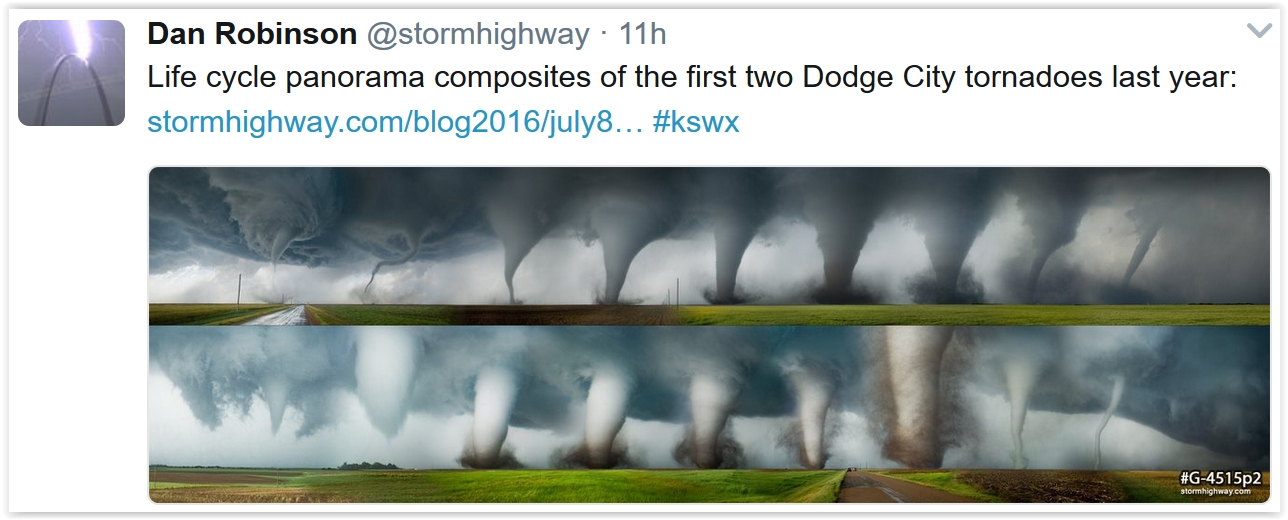
Joplin's Recovery By The Numbers.
In the movie "Twister" there is a reference to an F-5 tornado being
"the finger of God". Exhibit A: Joplin, Missouri. Here's an excerpt
from
Missourian: "
Six
years after an EF5 tornado caused $2.8 billion worth of damage, the
city of Joplin continues its steady recovery. The costliest tornado in
U.S. history killed 161 people and injured more than one thousand on May
22, 2011. Much has changed since that day, which forced the city to
restart. One of the significant impacts tornadoes have is on the the
people of the cities it destroys. Joplin was no different, and its
population suffered a dramatic drop because of the tornado. While it’s
difficult to estimate exactly how many residents left the city in the
immediate aftermath of the storm, the city underwent a dramatic
downsize. Between 2011 and 2012, the city’s population fell 1.8 percent
to 50,244, according to data from the U.S. Census Bureau..."
Photo credit: Kristan Lieb - Missourian File Photo. "
An
area of the city of Joplin lies in shambles on May 24, 2011, after an
EF5 tornado flattened a mile-long swath of Joplin and killed 161 people
two days earlier."
The Day a Geomagnetic Storm Almost Started World War III. Dr. Marshall Shepherd explains how the world dodged a bullet in a piece at
Forbes: "...
NORAD’s
Solar Forecast Center in Colorado Springs issued a warning, that a
significant worldwide geomagnetic storm would occur within the next
36-48 hour. It seems that this alert was passed to the highest levels of
government, but not to local commands. May 23, the geostorm disrupted
the radars at all three stations of the Ballistic Missile Early Warning
System, located in Cape Cod Air Force Station (Massachusetts), Beale
Air Force Base (California) and Clear Air Force Station (Alaska). Local
commanders of the airfields, considering a possible Soviet attack,
ordered nuclear weapons ready to launch. As all stations were being
jammed at the same time and during daylight, researchers at NORAD
realized that not Soviets, but the sun was interfering with the radar
stations. Information made it to commanders in time to stop the
airplanes, but the military realized, even more, the importance to
monitor space weather..."
Graphic credit: "
Artist's rendition of Earth's magnetosphere." Source
Wikipedia, image in public domain.
"Gas Apocalypse' Looms Amid Power Plant Construction Boom.
Bloomberg has the details: "
The
glut of cheap natural gas from a single, gigantic, shale basin that
straddles the Northeast, mid-Atlantic and Midwest has sparked a massive
construction boom of power plants. Dozens have been built in the past
two years alone. There’s just one problem: There isn’t nearly enough
electricity demand to support all the new capacity. And as wholesale
electricity prices plunge, industry experts are anticipating a fire sale
of scores of plants in the region. Many, in fact, have already been
sold along the PJM Interconnection LLC
grid, the nation’s largest, encompassing 13 states from Virginia to
Illinois. “Everything in fossil fuels is for sale,” said Ted Brandt,
chief executive officer at Marathon Capital LLC, a
mergers-and-acquisitions adviser in Chicago. “People are bleeding...”
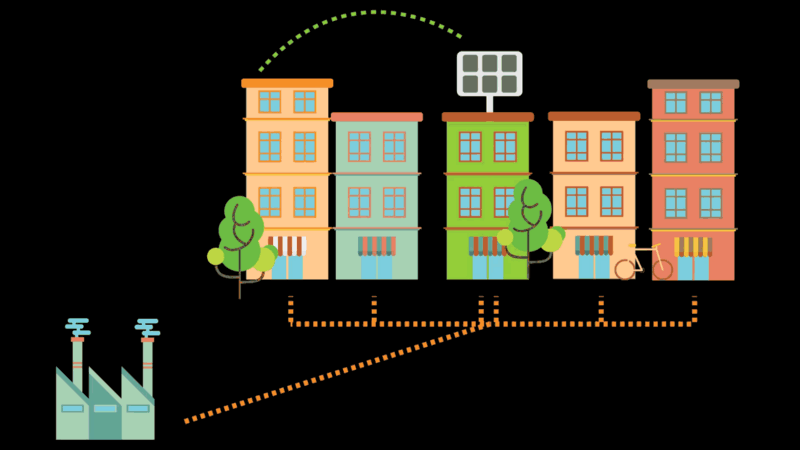
How to Sell Solar Power To Your Neighbors. NexusMedia has details on a new renewable energy-sharing program spinning up in Brooklyn: "...Admittedly,
from the grid’s point of view, this is bad for business. LO3 is
allowing customers to circumvent the grid and buy electricity directly
from each other. But Kessler said the grid can use the digital meter to
their advantage. For example, in the middle of the day, when demand for
power peaks, grid operators typically turn to small, expensive and
heavily polluting gas-fired power plants. Using the TransActive Grid
meter, the grid could instead pay homeowners to shut off their lights,
TVs or their appliances. Or, the grid could buy back electricity
generated by rooftop solar panels or stored in electric cars. This would
reduce transmission costs..."
Image credit: "Typically,
consumers by electricity from a centralized utility. LO3 Energy is
making it possible for them to buy power directly from their neighbors." Source: Nexus Media/Freepik.
Hit Hard by Coal's Decline, Eastern Kentucky Turns to Drones, Tomatoes, Solar Energy. Here's a clip from
The Wall Street Journal: "
With
coal production on the decline, one energy company is pursuing a
project that might seem heretical in this eastern Kentucky mining
region: a solar-energy farm. Berkeley Energy Group and a subsidiary of
the French renewable-energy company EDF Energies Nouvelles aim to begin
building a $100 million facility on a reclaimed strip mine next year. As
the state’s largest solar complex, it would produce as much as 100
megawatts of electricity. To fill an estimated 100 jobs that would be
created, the partners would give priority to unemployed coal miners. The
project would “put miners back to work and diversify our holdings and
diversify the region,” said Ryan Johns, project development executive at
Berkeley Energy. “It’s kind of a new frontier for our area...”
Photo credit: "
Hazard,
one of eastern Kentucky's principal coal towns, is now home to a
program in the local community college that trains laid-off miners to
work as linemen in the electric industry." Andrew Spear for The Wall Street Journal.
Large or Small, Cities' 100% Renewable Energy Pledges Are More Than Symbolic.
Why are people going green? Concern over climate change may be part of
the incentive but in the end it's about saving money and become more
independent and self-reliant. Here's an excerpt from
Southeast Energy News: "
It
goes without saying that Atlanta, Georgia and Abita Springs, Louisiana
are dramatically different places. As of this month, however, the two
have something in common: they are some of the first Southeastern cities
to commit to 100 percent renewable energy. Atlanta has a Democratic
mayor and a fairly progressive city council; Abita Springs leans older
and more conservative with a Republican mayor. But for both places, the
decision was more about economic development than climate change. And in
order for these goals to be more than symbolic, utilities and cities
must change how they run – especially in a place as large as Atlanta..."
Photo credit: Abita Springs, Louisiana.
Climate-Friendly Car Guide. Interested in lowering your CO2 emissions and saving money, but debating between electric or a hybrid? Climate Central has a
unique guide that walks you through the process of deciding which option makes the best sense on a state by state basis: "
How
climate friendly electric and plug-in hybrid electric cars are depends
on where you charge them. In states where electricity generation relies
heavily on fossil fuels, like coal and natural gas, powering electric
cars can be more emissions intensive than conventional gas-powered cars.
On the other hand, states with large proportions of hydropower,
renewables and nuclear power provide a low-emissions power grid for
electric cars. The Climate-Friendly Car Guide allows you to compare
specific 2017 model-year cars effectively by using your state’s most
recent electricity grid..."
AI (Artificial Intelligence) Predicts Next U.S. Recession To Start in 2019. Now here's a forecast, brought to you by
Seeking Alpha: "
March
2019 is the current target date for the next US recession, says a
machine learning "forecasting engine" developed by San Diego-based
Intensity Corporation. Intensity boasts a number of very large tech
firms as clients - Apple (NASDAQ:AAPL), IBM Corp. (NYSE:IBM), Microsoft (NASDAQ:MSFT), and others - and is itself comprised by a team of data scientists, statisticians, and econometrically minded PhDs..."
Forget Plastics - Think Asteroids.
A new report from Goldman Sachs suggests mining of metals on asteroids
may be a trillion-dollar industry. Quartz has details in an
infographic.
Supersize My Hamburger Please. The world's largest (commercially available) hamburger? Atlas Obscura explains where to track it down. Bring some friends: "...This
massive meaty creation, aptly named the “Absolutely Ridiculous Burger,”
holds the Guinness record for the world’s largest commercially sold
hamburger, and it can be all yours for just $399. The typical Absolutely
Ridiculous Burger weighs in at 150 pounds, with the official
record-setter massing in at an even more whopping 338.6 pounds, double
the weight of an average-sized human. The burger is so big that it takes
22 hours to make, three people to flip it over, and 100 pounds of
excess grease to perfect. It’s so colossal that on an episode of Man Vs.
Food, a team of 41 people couldn’t conquer the thing in a whole two
hours of time..."
Image credit:
Guinness World Records.
Singapore "Vending Machine" Dispenses Ferraris, Lamborghinis. Taking wretched excess to a whole new level, here's a report from
Reuters: "
Forget
about soft drinks and potato chips - a "vending machine" in Singapore
is offering up luxury vehicles, including Bentleys, Ferraris and
Lamborghinis. Used car seller Autobahn Motors opened a futuristic
15-story showroom in December, with vehicles on display in 60 slots,
billing it as the "world's largest luxury car vending machine".
Customers on the ground floor choose from a touchscreen display which
car they wish to see. The car arrives within one to two minutes thanks
to an advanced system that manages vehicle retrieval, the company says..."
Photo credit: "
An
exotic used car dealership designed to resemble a vending machine in
Singapore May 15, 2017. The dealership houses up to 60 exotic cars in a
15 story building which uses a fish-bone type lift system to deliver
cars to clients within minutes." Reuters/Thomas White.
TODAY: Some AM sun, shower late. Winds: SE 8-13. High: near 70
THURSDAY NIGHT: A shower or sprinkle. Low: 56
FRIDAY: Peeks of sun, stray shower or thundershower. Winds: W 7-12. High: 73
SATURDAY: Partly sunny, pop-up shower late? Winds: W 10-15. Wake-up: 57. High: 76
SUNDAY: Mix of clouds and sun, lukewarm. Winds: NW 8-13. Wake-up: 56. High: 72
MEMORIAL DAY: Mostly cloudy, cooler - few showers. Winds: NW 10-20. Wake-up: 53. High: 63
TUESDAY: More clouds than sun, still brisk. Winds: NW 10-20. Wake-up: 50. High: 59
WEDNESDAY: Mix of clouds and sun, where's spring? Winds: NW 10-15. Wake-up: 47. High: 63
Climate Stories...
 Pope Lends Weight to G-7 Push to Bind Trump to Climate Deal. Bloomberg
Pope Lends Weight to G-7 Push to Bind Trump to Climate Deal. Bloomberg reports: "
Pope
Francis joined an international chorus urging Donald Trump to meet U.S.
commitments on climate change in talks at the Vatican Wednesday.
Francis gave the U.S. president a copy of his 2015 encyclical calling
for urgent, drastic cuts in fossil-fuel emissions after a half-hour
meeting in his private study. Francis’s choice of gift suggests he is
adding his voice to those pressing Trump not to renege on the Paris
accord, which is the cornerstone of global efforts to limit climate
change. The Vatican said in a statement that the talks focused on
international affairs and the promotion of peace, with particular
emphasis on health care, education and immigration..."
Mapping 50 Years of Melting Ice in Glacier National Park.
The New York Times tackles the trends and uses infographics to tell the story: "
Glacier
National Park is losing its glaciers. The flowing sheets of ice
scattered throughout the Montana park shrank by more than a third
between 1966 and 2015, according to new data
from the United States Geological Survey and Portland State University.
Using aerial and satellite imagery, researchers traced the footprints
of 39 named glaciers in the park and surrounding national forest. They
found that 10 had lost more than half their area over 50 years..."
 Warming Has Increased U.S. Growing Season by 13 Frost-Free Days
Warming Has Increased U.S. Growing Season by 13 Frost-Free Days.
The Independent has details: "
The
number of frost-free days in the northern United States has increased
by more than 13 days in the past 100 years, according to new research.
The other main areas of the mainland US also saw significant increases
in the number of days without frost, essentially the growing season –
10.7 days in the west, 8.6 in a central region and 7.7 days in the
south. Global warming was one of the reasons for the trend, but the
researchers also found changes to local cloud cover and atmospheric
circulation patterns played a part..."
File photo: iStock.
Why Some Republicans Are Warming to Climate Action. If markets can provide solutions, not government, then (many) in the GOP may be onboard, according to
Christian Science Monitor: "...
Having
those costs reflected in the price of gas and electricity would hold
fossil fuel companies accountable for their environmental impact, the
theory goes. The higher price, in turn, would incentivize innovation in
renewables and encourage consumers to power their lives in
climate-friendly ways – all while keeping government intervention at a
minimum. “We’re already paying the full cost of coal-fire electricity,”
Inglis says. “It’s in the healthcare system. It’s in the climate damages
[they cause]. So go ahead and put that on your meter and let’s see how
wind and solar do then.” More than pushing a particular solution,
however, Inglis aims to mobilize conservatives into joining the
discourse instead of just going on the defensive against what he calls
the environmental left – thus helping to sever the ties between climate
action and political identity..."
Eating on the Brink: How Food Could Prevent a Climate Disaster. Civil Eats helps us connect the dots between diet, agriculture and AGW: "...
What we eat is responsible for a whopping one-third of all atmospheric warming today. Global meat and dairy production together accounts for roughly 15 percent of total greenhouse gas emissions,
making the livestock industry worse for the climate than every one of
the world’s planes, trains, and cars combined. At the meetings,
Christine Figueres, who led the United Nations Framework Convention on
Climate Change, reminded us that climate stability requires limiting
warming to under 1.5 degrees Celsius. To do that, we need to start
reversing current emissions trajectory, start a downward turn, by 2020.
Yes, 2020. That means engaging every sector, food included..."
Half the Global Population Could Face 'Unknown' Climates by Mid-Century. Here's a clip from
EcoWatch: "
Billions of people across the world could see climates they've never experienced before by the middle of the century, a new study
said. Using a measure of climate "familiarity," the researchers showed
that the tropics in particular are likely to experience conditions that
are virtually unheard of for the region in the present climate. But
keeping global temperatures rise below 2°C above pre-industrial levels
could help keep the climate "familiar" within this century, the
researchers said. That means people alive today could see the benefits
of mitigation within their lifetimes..."
Photo credit: "Hurricane Sandy floods a street in Lindenhurst, Long Isoland." Jason DeCrow/CC by SA/2.5"

Scientists Planting 400 Acres of Minnesota Pines to Survive Climate Change. Will
our grandchildren and great grandchildren have the same up north
experience with pine trees, loons and eagles? The jury is still out, but
I wouldn't take anything for granted.
Star Tribune reports: "...
This
summer they’re embarking on a project to plant 400 acres with
cold-loving evergreens like jack pine and tamarack in carefully selected
“conifer strongholds” — places that they predict will stay cooler or
wetter or have better soil, increasing the chances that a few of each
species will survive for the next generation as Minnesota grows warmer.
“We are trying to get us in better shape for the centuries to come,”
said Meredith Cornett, a forest scientist with the Nature Conservancy in
Minnesota who is heading up the project. The aim is to preserve
northern forest species — not just the trees but also the mosaic of
plants and animals that rely on them — to maintain biodiversity. Both
will be exceedingly difficult thanks to a double whammy of the region’s
past and it’s future..."
Photo credit: Brian Peterson, Star Tribune. "
The forest north of Park Rapids, Minnesota, is a mix of aspen, birch and conifers."
Significant Global Climate Events in April. Here's an excerpt from
NOAA: "
For
the third consecutive month, the monthly temperature and year to date
ranked second warmest in the 138-year record. At the poles, sea ice
extents were at or near record low levels. The average global
temperature for April 2017 was 1.62 degrees F above the 20th-century
average of 56.7 degrees, according to the analysis by scientists from
NOAA’s National Centers for Environmental Information. This was the
second highest for April in the 1880-2017 record, behind last year by
0.31 degrees..."

See the Fortune 500 Companies Doing the Most to Stop Climate Change. An article at
Fortune caught my eye: "
President Trump has made it clear that boosting business is his priority, not combating climate change. In March Trump signed an executive order to undo Obama’s Clean Power Plan, and he’s vowed to withdraw the U.S. from the Paris climate agreement.
But the biggest companies in the U.S. continue to embrace clean energy
policies. So says a new report by Calvert Research, CDP, Ceres, and
World Wildlife Fund called “Power Forward 3.0.” The study found that 240
companies in the 2016 Fortune 500 had climate-related goals, up from 215 a few years ago. Here, the 2015 CO2-equivalent savings of the 56 companies in the Fortune 100 that reported results in 2016..."
Graphic credit: Nicolas Rapp.
"Put Up or Shut Up". WRAL's Greg Fishel Goes Off on Climate Change Deniers. Greg
is Chief Meteorologist at WRAL, and my oldest friend (we were resident
weather-nerds in our high school and went on to attend Penn State at
roughly the same time). Greg is brilliant and a terrific communicator,
and he doesn't suffer fools gladly. Here's an excerpt from
News & Observer: "
Popular local weatherman Greg Fishel had strong words for climate change deniers on his Facebook page
on Sunday. Fishel, chief meteorologist at WRAL, went off on people who
question the science behind climate change, telling them to “put up or
shut up.” The post had earned more than 3,500 reactions by Monday
afternoon. “You know everybody reaches their breaking point and quite
frankly I have reached mine with the folks who post all over the
internet about the scientific fallacies of man induced climate change,”
Fishel wrote. “All of them are guest bloggers or essayists. None of this
stuff has ever been published in a peer reviewed atmospheric science or
climate journal. But we live in an age today where higher education and
research are no longer respected. Heck, think of all the money my
parents wasted on my education when I could have waited for the age of
twitter and Facebook and declared myself as an expert in the field of my
choice...”
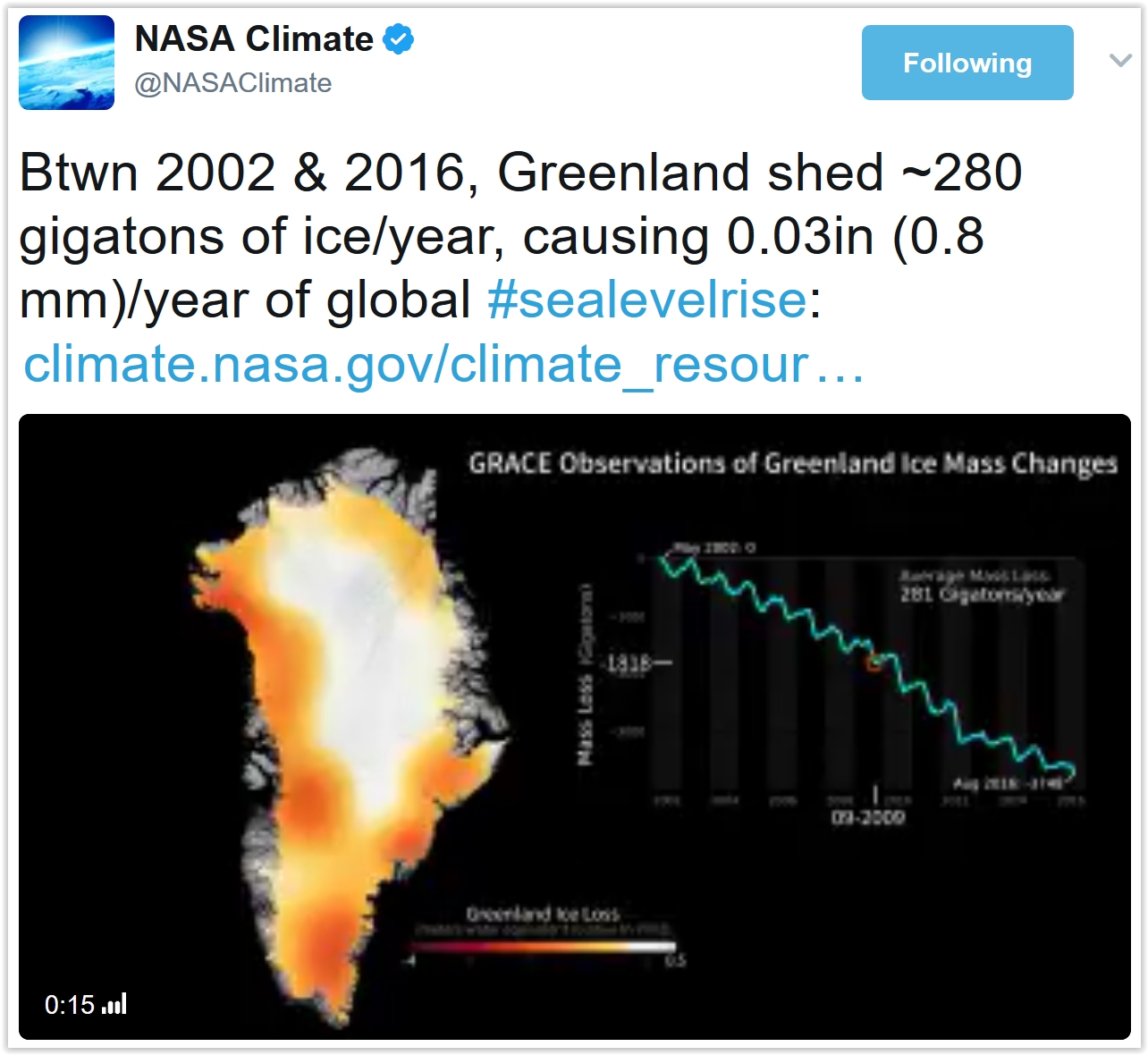
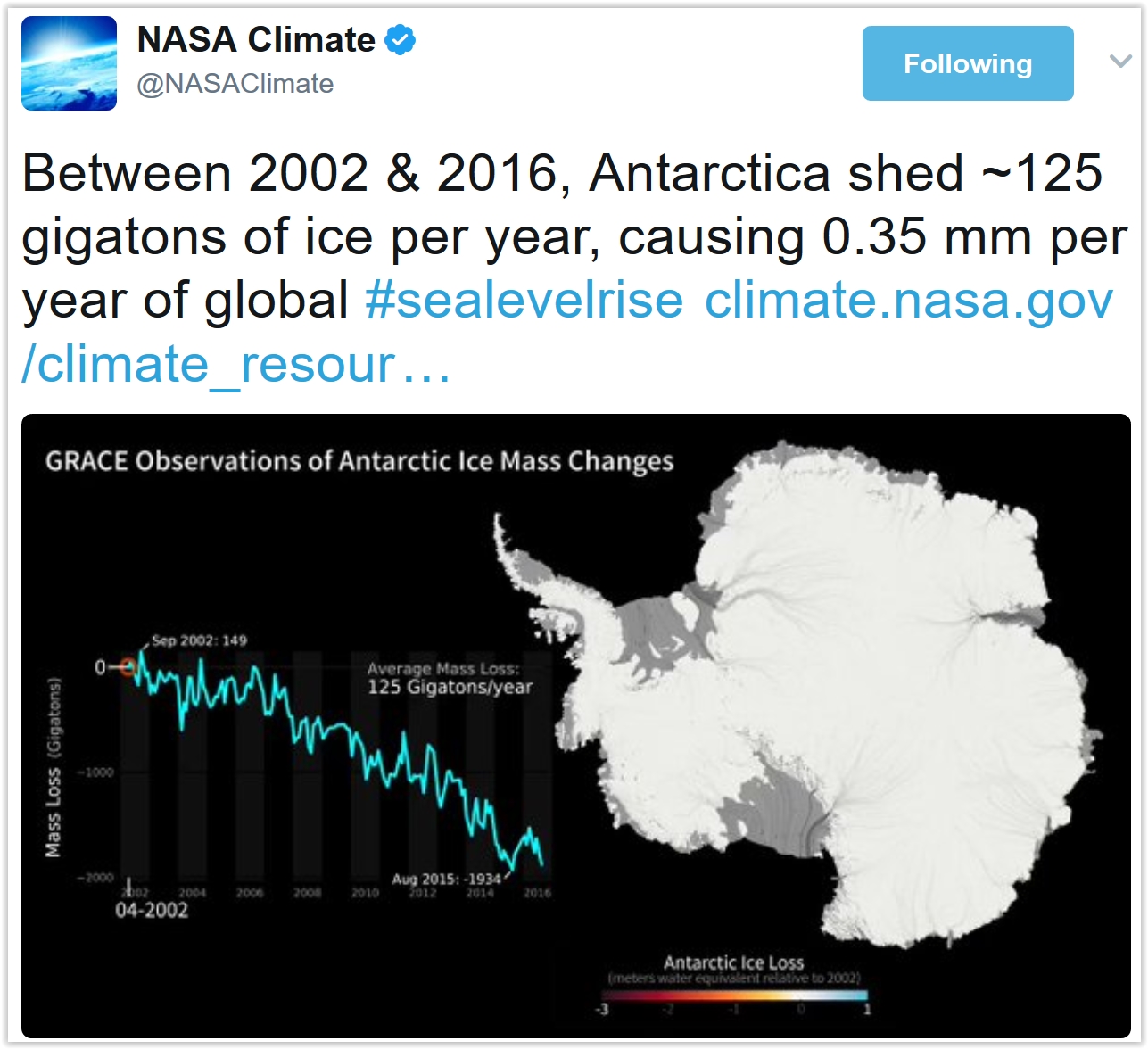
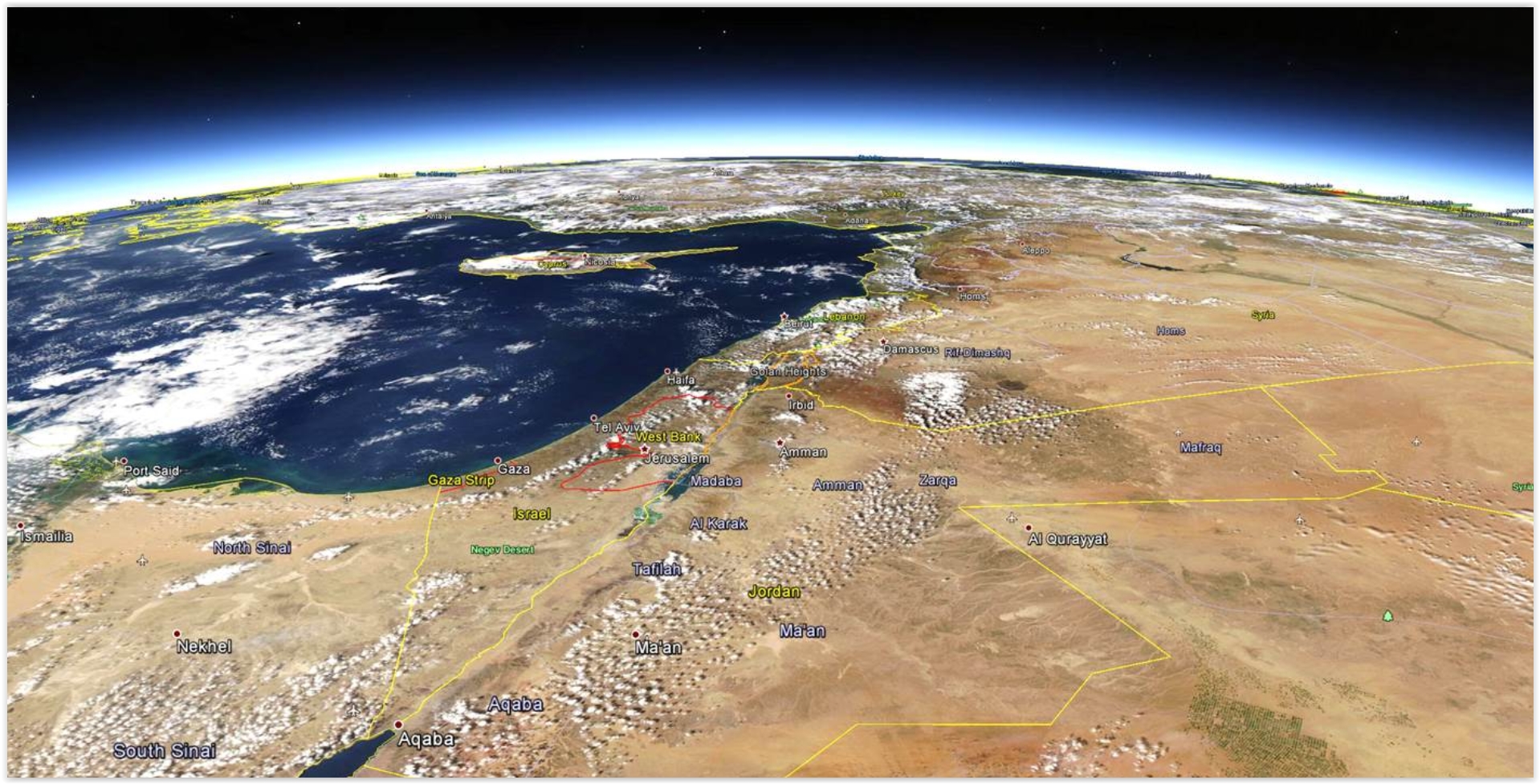 NATO Lawmakers Warn Climate Change May Worsen Middle East Security Risks. Reuters
NATO Lawmakers Warn Climate Change May Worsen Middle East Security Risks. Reuters has the story: "
Climate
change will worsen food and water shortages in the Middle East and
north Africa, and risk triggering more conflict and mass migration, with
serious implications for the wider world, lawmakers from NATO's
Parliamentary Assembly said Monday.
"The long-term prospects for food and water security in the MENA region
are dire," said Osman Askin Bak, a member of the Turkish Parliament who
will present the draft report on Saturday at the Parliamentary Assembly
- a gathering of senior parliamentarians from the North Atlantic Treaty
Organization's 28 member states. "Climate change will worsen the region's outlook," he added..." (File image: NASA MODIS).
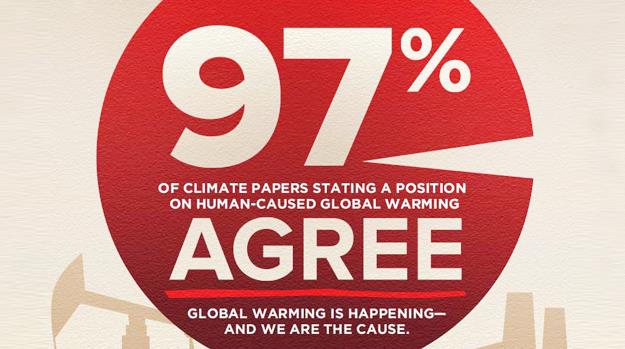 Why Scientific Consensus is Worth Taking Seriously. Here's a clip from Bloomberg View: "Following
the pack is not part of the scientific method. The point is to follow
the evidence. And that leaves room for ambiguity in interpreting the
survey results showing that 97 percent of climate scientists agree
that global warming is real and that human-generated greenhouse gases
are a major cause. The National Academy of Sciences, American Physical
Society, American Chemical Society and other relevant scientific organizations all
agree, too. For some, this consensus proves that climate change is real
and that humans must take immediate action against it. But others,
citing history, say the consensus view has been wrong before. Why should
we believe it now? For example, scientists once believe the earth
was headed into an ice age. So why should we trust them when they say
the globe is warming?
Why Scientific Consensus is Worth Taking Seriously. Here's a clip from Bloomberg View: "Following
the pack is not part of the scientific method. The point is to follow
the evidence. And that leaves room for ambiguity in interpreting the
survey results showing that 97 percent of climate scientists agree
that global warming is real and that human-generated greenhouse gases
are a major cause. The National Academy of Sciences, American Physical
Society, American Chemical Society and other relevant scientific organizations all
agree, too. For some, this consensus proves that climate change is real
and that humans must take immediate action against it. But others,
citing history, say the consensus view has been wrong before. Why should
we believe it now? For example, scientists once believe the earth
was headed into an ice age. So why should we trust them when they say
the globe is warming?..."
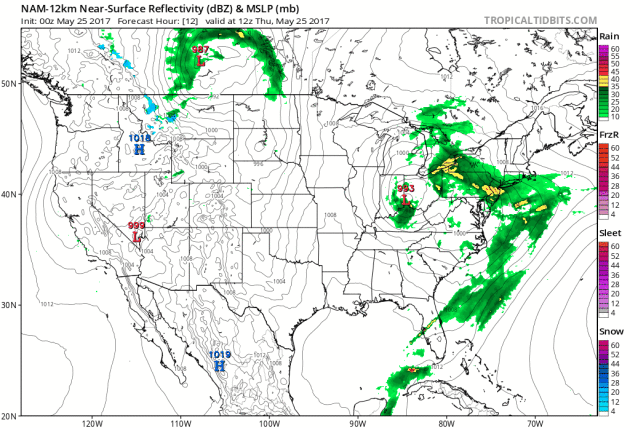

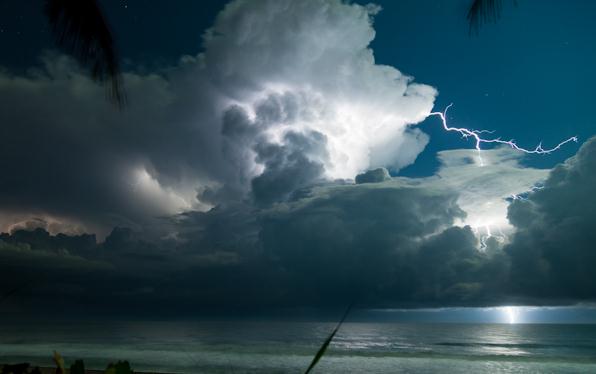




No comments:
Post a Comment